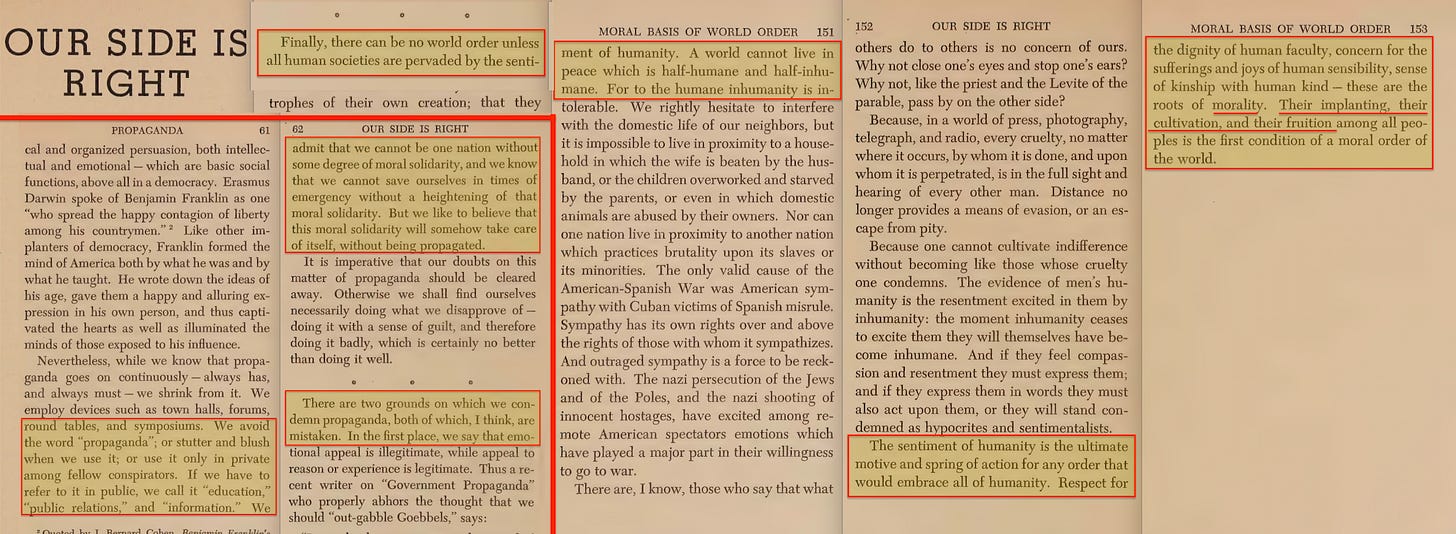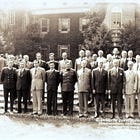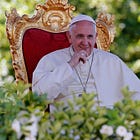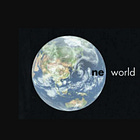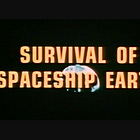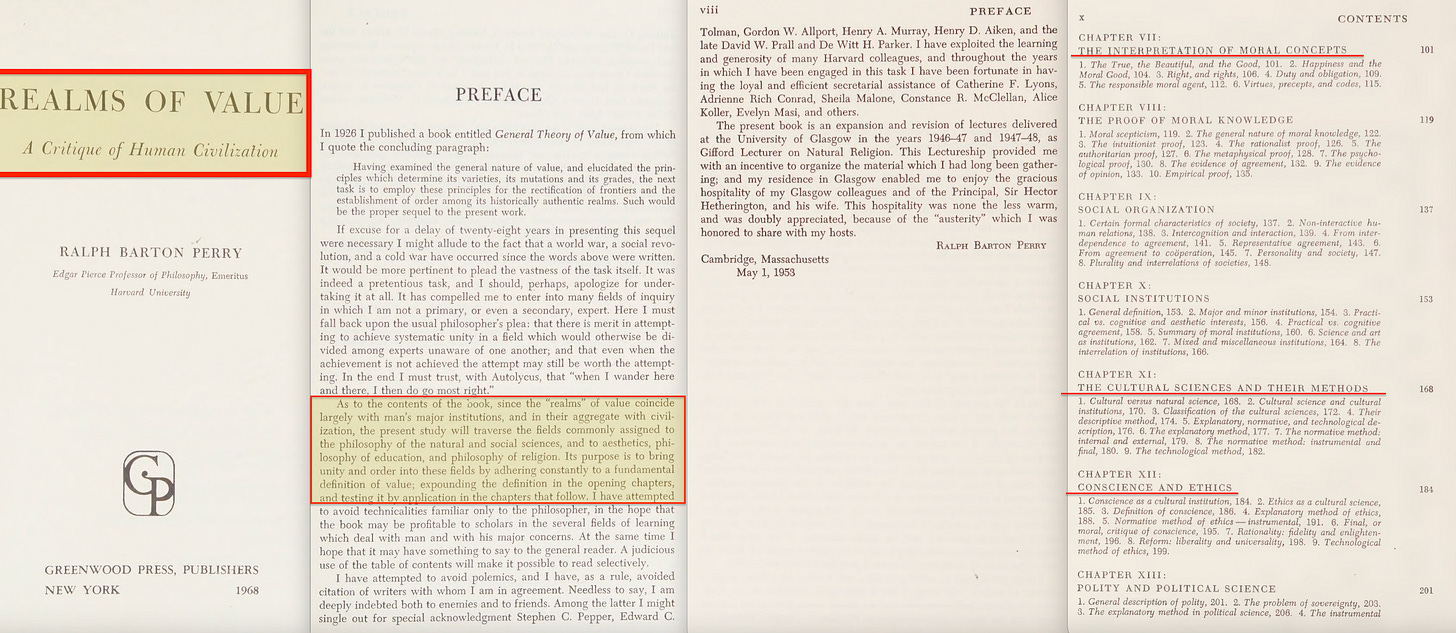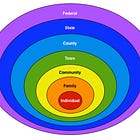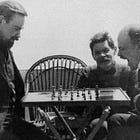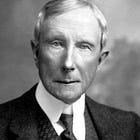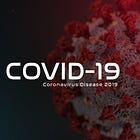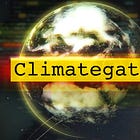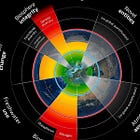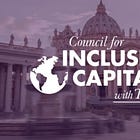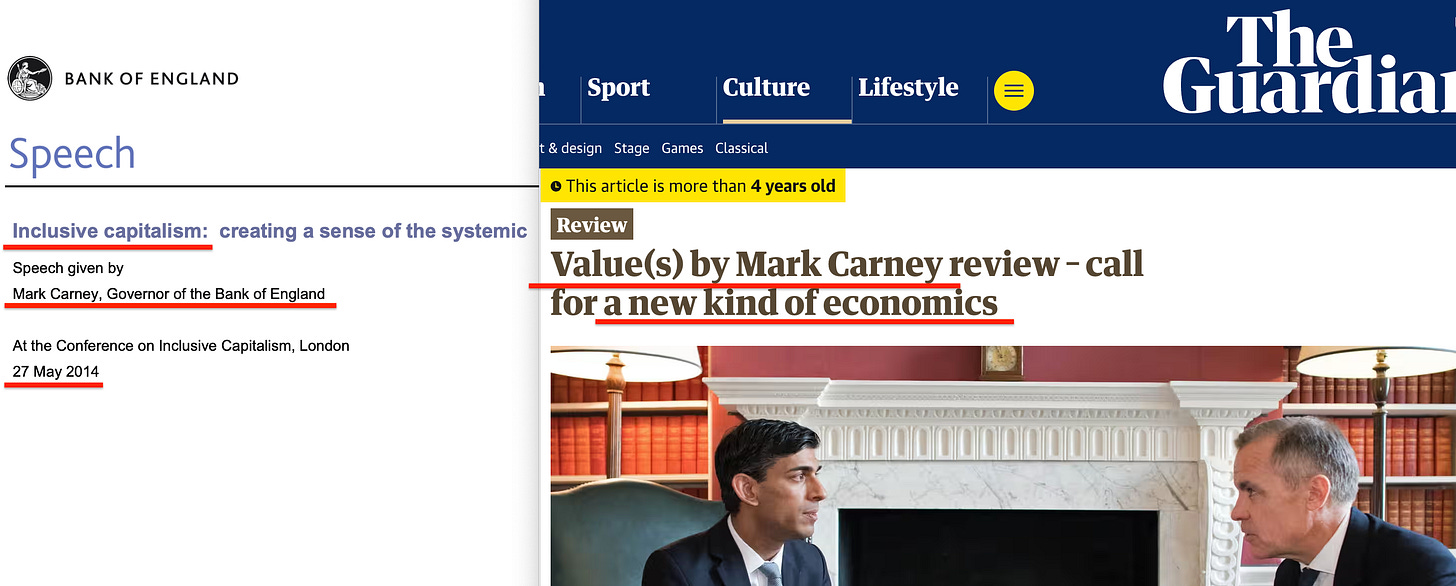Few figures have been as systematically overlooked as Ralph Barton Perry, despite having constructed an ambitious philosophical architecture: a system of ethics enabling a scientifically managed ‘moral economy’ designed to subordinate political institutions to expert management under the banner of ‘ethical necessity’.
Not only did Perry conceptualise a ‘scientific moral economy’, but nearly every component of his blueprint is operational in the contemporary global governance apparatus.
What makes Perry's work particularly remarkable is not just its intellectual scope, but its prophetic precision. Writing decades before the technological capabilities even existed to implement his vision, Perry nevertheless discussed the exact mechanisms through which moral authority could be systematically captured, institutionalised, and operationalised across every domain of human experience. His concept of the ‘moral economy’ prefigures with uncanny accuracy today's stakeholder capitalism, ESG frameworks, and impact investing — systems where economic activity is systematically subordinated to expert-defined ethical criteria rather than democratic choice or market mechanisms. His philosophical blueprints read less like historical curiosities than like instruction manuals for a form of governance that transforms democratic choice into expert management — while preserving the appearance of freedom through voluntary compliance.
Executive Summary
From his debut in The Moral Economy (1909) through The New Realism (1912), The Free Man and the Soldier (1915), and on to Realms of Value (1954). Perry likened moral coordination to a quasi-banking clearing-house — individual choices remain free but are centrally reconciled for systemic harmony. He grounded the mechanism in objective value theory, showing how disciplined institutions can liberate rather than constrain, and explained how crisis and information management create voluntary compliance. Finally, he expanded the clearing-house logic across eight realms — from religion and aesthetics to law and international relations — culminating in a planetary governance model.
Each pillar of Perry’s blueprint has been built into our global governance stack. At the financial core, the BIS Innovation Hub’s mBridge/Helvetia/Genesis/Nexus suite functions as a literal values clearing-house — transactions routed through real-time ethical filters. ISO standards and UN SDG indicators translate interests into quantifiable ‘value units’, feeding digital-twin models that automate policy tweaks. ESG mandates, pandemic treaties, content-moderation regimes, and AI-ethics committees enact Perry’s vision of voluntary compliance through moral authority. Crisis triggers — nuclear risk, climate emergency, public-health threats — serve as strategic catalysts, justifying expert overrides disguised as ‘collective empowerment’.
Perry’s moral economy didn’t emerge by accident; it was meticulously designed — and with the Pandemic Treaty coming into force, it is now being technologically cemented. However, the full system has not yet hardened.
The fat lady has yet to sing.
The Moral Economy (1909)
Perry's system began with a deceptively simple proposition in The Moral Economy1: morality should be understood as 'the organisation of life's interests into a harmonious economy'. This seemingly abstract philosophical claim contained the seed of a revolutionary approach to social organisation that would challenge the fundamental assumptions of democratic governance.
Traditional morality suffers from its dependence on religious principles practically separated from contemporary human life. Religious ethics proclaim universal commandments that often conflict with practiced reality. Democratic politics reduce moral questions to majority preference without consideration of optimal outcome. What was needed, Perry claimed, was a scientific approach to moral organisation that could coordinate competing interests through rational management rather than arbitrary authority or popular whim.
The economic metaphor was neither casual nor incidental. Just as local banks could operate with apparent autonomy while remaining dependent on centralised clearing mechanisms that maintained ultimate oversight, Perry envisioned moral values being processed through coordinating institutions that would mediate conflicts and ensure systemic harmony.
This clearing house model solved a fundamental problem of scale. Individual moral decisions appeared to remain autonomous — people would continue making personal choices about their lives and relationships. But these decisions would be processed through institutional mechanisms that could identify conflicts, assess broader implications, and guide resolution according to scientific principles — rather than traditional authority or democratic deliberation.
Effective social control required not the elimination of choice but its systematic channelling through mechanisms that could shape outcomes institutionally, while still preserving the appearance of freedom. The moral economy would thus achieve coordination not through coercion but through the rational organisation of interests according to scientific principles that made optimal outcomes appear naturally compelling.
The New Realism (1912)
But the moral economy needed solid philosophical grounding to distinguish it from technocratic manipulation. Perry's contribution to The New Realism2, provided this foundation by establishing that moral values were objective, measurable entities rather than subjective preferences or cultural constructions.
The New Realist movement positioned itself against both empiricism and extreme idealism34. For Perry's moral economy, this philosophical position was essential. If values were merely subjective preferences, moral coordination would reduce to preference aggregation — democratic politics with better information processing. If values were cultural constructions, moral organisation would remain captive to traditional authorities and local practices. But if values were objective features of reality accessible through scientific investigation, expert institutions could claim legitimate authority to discover, measure, and systematically coordinate them.
The New Realist framework transformed moral questions from matters of judgement into problems of measurement. Rather than asking what values different communities endorsed, experts could investigate what values actually promoted human flourishing per scientific criteria. Rather than adjudicating between competing moral traditions, institutional authorities could identify optimal configurations of interests and guide social organisation accordingly.
This philosophical foundation enabled Perry's system to present itself as transcending politics. The moral economy would not impose particular values on society but would discover and systematically implement the values that rational investigation revealed as objectively optimal for human coordination. Opposition would represent ignorance of relevant facts or resistance to rational organisation.
The Free Man and the Soldier (1915)
Perry's emerging system faced a crucial challenge: how could comprehensive coordination be achieved without destroying individual freedom? The Free Man and the Soldier5 provided Perry's answer. Wartime conditions revealed the compatibility between individual autonomy and systematic control.
Perry observed that soldiers achieved freedom through disciplined submission to military authority. Systematic training and clear command structures didn't constrain liberty — they liberated individual potential by channelling it towards meaningful collective purposes. The discipline that appeared restrictive actually freed soldiers from the chaos and anxiety of unlimited choice.
This suggested a general principle: true freedom emerged not from the absence of constraint but from participation in rationally organised systems that aligned with collective needs. The moral economy could preserve and enhance individual autonomy by providing institutional frameworks that made optimal choices appear natural rather than externally imposed.
Perry identified several mechanisms for achieving this alignment:
Clear institutional purposes would eliminate confusion.
Systematic training would develop capabilities.
Rational authority would enhance individual judgement — by connecting personal decisions to optimal, collective outcomes.
Perry showed how institutional loyalty could become a source of meaning rather than a constraint on authentic selfhood. Just as soldiers found purpose through service to something larger than individual gratification, citizens of a moral economy could achieve fulfilment through participation in scientifically organised social systems. The key was ensuring institutional purposes aligned with rational principles rather than arbitrary authority.
This provided the psychological foundation for voluntary compliance with expert management. People would experience systematic coordination not as external domination but as liberation from chaos and meaninglessness. The moral economy would achieve control not through coercion but through institutional design that made compliance appear as personal empowerment and social responsibility.
The Present Conflict of Ideas (1918)
Writing during World War I, Perry recognised that implementing the moral economy would require not just institutional construction but comprehensive ideological transformation. The Present Conflict of Ideas6 provided his analysis of how competing worldviews could be systematically mobilised to support rational social organisation while undermining traditional sources of authority that might resist expert management.
Four major intellectual currents that shaped contemporary thought were identified: materialism, spiritualism, pragmatism, and realism. Rather than viewing these as incompatible philosophical positions, he analysed them as mobilisable resources that could be synthesised to support the moral economy depending on strategic requirements and audience characteristics.
Materialism provided the scientific foundation for objective measurement and systematic analysis.
Spiritualism contributed the moral authority and transcendent purpose necessary for sustained social commitment.
Pragmatism offered the experimental attitude and flexible adaptation required for continuous institutional improvement.
Realism supplied the philosophical justification for expert authority based on superior access to objective truth about social organisation.
Perry showed how these could be combined within a single system. This preserved their emotional and motivational power while subordinating them to scientific management. Citizens could maintain materialist confidence in objective knowledge, spiritualist commitment to higher purposes, pragmatist openness to institutional adaptation, and realist trust in expert authority — all within frameworks designed by credentialed institutions claiming scientific legitimacy.
Perry further demonstrated how crisis conditions created opportunities for intellectual mobilisation by disrupting traditional authorities and creating demand for systematic responses to complex challenges. Wartime urgency justified experimental institutional arrangements that would be rejected under normal conditions. The evident failure of existing systems to prevent catastrophic conflict undermined confidence in traditional governance while creating emotional receptivity to rational alternatives.
This analysis provided the blueprint for using intellectual mobilisation to accelerate institutional transformation. Rather than waiting for gradual cultural evolution, strategic thinkers could leverage crisis conditions to promote rapid adoption of new frameworks while traditional resistance remained disorganised and demoralised. The key was ensuring that proposed alternatives appeared to address evident problems while actually advancing systematic institutional capture.
General Theory of Value (1926)
Perry's theoretical framework required a mechanism for converting diverse interests into measurable units that could be systematically coordinated within the moral economy. General Theory of Value7 provided this crucial component; all value claims could be reduced to degrees of interest-fulfilment measurable according to scientific criteria.
Perry argued that apparent diversity in human values reflected not fundamental incommensurability but incomplete analysis of underlying interest structures.
Religious values could be analysed as interest in transcendent meaning and community belonging.
Political values could be decomposed into interests in security, recognition, and collective decision-making.
Economic values could be understood as interests in material welfare and productive activity.
Cultural values could be examined as interests in identity, expression, and social continuity.
Once this analysis was completed, seemingly incompatible value commitments could be translated into comparable measurements of interest-fulfilment that enabled systematic optimisation across different domains. Expert institutions could use scientific methods to determine which institutional arrangements maximised aggregate interest-fulfilment while maintaining acceptable distributions across different types of interests and social groups.
This framework solved the coordination problem that had plagued earlier approaches to systematic social organisation. Democratic institutions aggregated preferences without systematic analysis of their underlying interest structure or consideration of optimal outcomes. Market mechanisms coordinated some interests efficiently but ignored others entirely — whilst generating outcomes that might conflict with aggregate welfare. Traditional authorities claimed to coordinate values but lacked systematic methods for measuring success or adapting to changing conditions.
Perry's system promised to combine the responsiveness of democratic institutions, the efficiency of market mechanisms, and the stability of traditional authorities. All within a scientific framework that could optimise outcomes whilst adapting continuously to new information and changing circumstances. Expert institutions would monitor interest-fulfilment across all relevant dimensions, identify suboptimal configurations, and implement systematic improvements through institutional adjustment.
The genius of this approach lay in its apparent objectivity. Rather than imposing particular values on society, expert institutions would discover and implement the value configurations that scientific analysis revealed as optimal for interest-fulfilment. Opposition would represent not legitimate disagreement about values but resistance to scientific optimisation of agreed-upon objectives — or misunderstanding of relevant evidence about optimal institutional arrangements.
Our Side Is Right (1943)
World War II provided Perry with the perfect laboratory for demonstrating how moral authority could be mobilised to justify comprehensive institutional transformation during crisis conditions. Our Side Is Right8 revealed Perry's sophisticated understanding of how information control and emotional manipulation could be employed to manufacture consent for expert management whilst maintaining the appearance of democratic deliberation and voluntary compliance.
Perry argued that democratic societies faced a fundamental challenge during existential conflicts: the need to mobilise unified commitment to collective action while preserving the individual freedom and open debate that defined democratic culture. Traditional approaches to this challenge — either suppressing dissent through authoritarian methods or maintaining complete openness despite strategic vulnerabilities — proved inadequate for modern conditions requiring both rapid coordination and sustained popular support.
The solution? ‘Propaganda in the service of truth’ — systematic information management that guided public opinion while eliminating discourse that might undermine necessary collective action. Expert institutions possessing supposedly superior access to relevant information could shape public communication with claimed legitimacy, promoting understanding of objective threats and optimal responses — whilst filtering out alternate perspectives.
Perry demonstrated how this approach differed from totalitarian propaganda through its grounding in objective analysis rather than arbitrary authority. Democratic propaganda should not create fictional threats or fabricate evidence but selectively present accurate information in ways that promoted appropriate emotional responses and behavioural choices. Citizens would receive true information about supposedly genuine dangers whilst being shielded from ‘harmful’ details that might interfere with necessary action.
The key was ensuring that information management served objective truth rather than institutional self-interest. Expert institutions would use scientific methods to identify genuine threats, assess optimal responses, and design communication strategies that promoted accurate public understanding whilst maintaining social cohesion. Citizens would experience this guidance as education rather than manipulation — because it enhanced rather than undermined their ability to make rational decisions about collective welfare.
Perry's analysis provided the philosophical foundation for information control as a legitimate function of expert institutions claiming scientific authority. Future crises would justify similar approaches as necessary measures for protecting democratic societies from threats that supposedly exceeded the capacity of public deliberation to address effectively. The moral economy would thus require continuous information management to maintain social coordination — whilst adapting to changing conditions and emerging challenges.
The Humanity of Man (1945)
As the war concluded, Perry recognised that sustainable implementation of the moral economy would require more than efficient coordination and crisis management. The Humanity of Man9 provided his analysis of how transcendent purpose and meaning could be systematically integrated into expert-managed institutions to ensure long-term social commitment and individual fulfilment within scientifically organised systems.
The nuclear threat that emerged immediately after the war provided the perfect case for Perry's framework. The prospect of species extinction through nuclear warfare created exactly the existential threat that made individual freedom appear dangerously naive — whilst expert coordination appeared essential for survival. Citizens would willingly submit to comprehensive security apparatus, military-industrial coordination, and international oversight bodies — all justified for the sake of preventing nuclear armageddon.
Perry, in essence, argued that human beings require connection to projects that go beyond individual concern. Traditional societies had provided this connection through religious institutions that promised eternal significance for earthly actions and cultural institutions that embedded individual lives within historical narratives extending across generations. Modern societies had weakened these connections without providing adequate replacements — creating widespread alienation and meaninglessness that undermined social stability and individual welfare. The moral economy could address this need by embedding individual activities within scientifically designed projects that served genuine long-term human interests whilst providing emotional satisfaction and personal meaning. Rather than offering fictional consolations or arbitrary traditions, expert institutions could identify objective purposes that connected individual development to species-wide advancement and environmental sustainability.
Several categories of transcendent purpose that could motivate sustained social commitment were identified:
The advancement of scientific knowledge that expanded human understanding and capability.
The elimination of preventable suffering through systematic social organisation.
The development of institutional arrangements that maximised human potential across different capabilities and cultures.
The establishment of sustainable relationships between human societies and natural environments.
These possessed several advantages over traditional sources of meaning. They were grounded in objective analysis rather than cultural tradition or religious authority, making them accessible to rational investigation and continuous improvement. They connected individual actions to collective outcomes in ways that could be measured and verified rather than accepted on faith. They provided emotional satisfaction through participation in supposedly meaningful projects whilst serving allegedly genuine rather than imaginary interests.
Most importantly? Pursuing these purposes required exactly the kind of expert-managed institutional arrangements that Perry's moral economy was designed to provide. Advancing scientific knowledge required coordinated research institutions. Eliminating preventable suffering required systematic social organisation. Maximising human potential required rational institutional design. Establishing environmental sustainability required comprehensive coordination across multiple domains. Citizens would thus choose participate in the moral economy not through submission to authority — but as contribution to purposes that provided meaning and fulfilment.
One World in the Making (1945)
Perry's vision required planetary-scale implementation to achieve its full potential. Written as the United Nations was being established, One World in the Making10 provided Perry's blueprint for operationalising the moral economy through international organisations that could coordinate expert management across national boundaries — whilst preserving local autonomy in domains that did not require global oversight. The exact framework embedded within the League of Nations by Zimmern, using Leonard S Woolf’s blueprint from 1916; ‘International Government’.
Perry rejected traditional approaches to international organisation based on power balancing between sovereign states or abstract legal frameworks divorced from institutional capacity for effective coordination. Instead, he proposed a functional approach that would gradually transfer authority over specific domains to international institutions as they demonstrated superior capability for achieving optimal outcomes according to scientific criteria — thus mirroring Woolf’s concept with impeccable precision.
This transfer would proceed through several interconnected channels. International law would provide the legal framework for expert authority whilst adapting continuously to new evidence about optimal institutional arrangements. Cultural exchange would promote shared understanding of scientific principles whilst respecting diversity in domains that did not require global coordination. Economic integration would create interdependencies that made national resistance to international optimisation increasingly costly and difficult to sustain. And — by sheer coincidence — Woolf highlighted free movement of labour and the elimination of tariffs as the mechanisms which would facilitate this latter integration.
Educational cooperation would develop shared curricula that trained future leaders in scientific approaches to social organisation whilst preserving local culture and tradition. Scientific collaboration would establish international research institutions that could develop methods for social coordination. Religious dialogue would identify shared spiritual principles that supported scientific approaches to collective welfare.
The institutional machinery for implementing both economic and cultural coordination would be embedded within the UN system itself — Julian Huxley co-founded UNESCO, the agency in charge of exactly science, education and culture, whilst his brother Aldous authored 'The Perennial Philosophy'11, an early framework for a global ethic that through Hans Kung12 would eventually justify expert override of traditional authorities by synthesising all religious traditions into universal principles compatible with scientific governance.
This approach would avoid the failures of previous attempts at international organisation. Rather than imposing uniform arrangements on diverse societies, functional organisation would allow for local variation within determined parameters that ensured compatibility with global optimisation. Rather than requiring immediate sovereignty transfers that would trigger nationalist resistance? Gradual functional integration would create incentives for voluntary adoption of international frameworks.
The result would ultimately be a planetary system that promised to combine the efficiency of unified coordination with the adaptability of decentralised implementation. Expert institutions would operate at whatever level proved optimal for particular functions whilst maintaining systematic communication and coordination across different domains. Local communities would retain autonomy over matters that did not affect broader outcomes whilst receiving guidance and support for implementing globally optimal approaches to shared challenges.
This vision provided the institutional framework for implementing Perry's moral economy at planetary scale whilst managing the political challenges that comprehensive transformation would inevitably generate. The moral economy would emerge not through revolutionary change but through systematic institutional evolution that made expert management appear beneficial and necessary rather than imposed and arbitrary.
However, this book is noteworthy for another reason. Ralph Barton Perry dedicated it to the memory of Wendell Willkie — the very man credited with launching the controversial ‘One World’ concept in 194313.
Realms of Value (1954)
Perry's final major work represented the culmination of nearly five decades of systematic thinking about scientific approaches to social organisation. Realms of Value14 demonstrated how the moral economy could be comprehensively applied across every domain of human experience through unified value logic that coordinated all institutional arrangements according to scientific principles.
Perry organised his analysis around eight interconnected realms:
Moral values that provided the foundation for institutional coordination
Religious values that supplied transcendent purpose and meaning
Aesthetic values that enhanced human experience and expression
Scientific values that generated reliable knowledge about optimal arrangements
Political values that organised collective decision-making
Economic values that coordinated production and distribution
Legal values that enforced systematic cooperation
International values that managed coordination across different societies.
Each realm operated according to the same fundamental logic whilst adapting to domain-specific requirements and constraints. Expert institutions would use scientific methods to identify optimal configurations of interests within each domain, implement systematic arrangements that maximised value fulfilment, and coordinate across domains to ensure compatibility and mutual reinforcement rather than conflict and waste.
The integration occurred through several mechanisms.
Shared measurement frameworks would enable comparison and optimisation across different types of values and institutional arrangements.
Coordinated planning would ensure that developments in one realm enhanced rather than undermined achievements in others.
Systematic communication would facilitate continuous learning and adaptation as new evidence became available about optimal approaches to value fulfilment.
Regular evaluation would identify suboptimal arrangements and guide improvement — whilst maintaining stability and predictability in domains that were functioning effectively. Professional training would develop expertise in scientific approaches to value coordination, whilst aiming to preserve domain-specific knowledge and cultural traditions.
Perry demonstrated how this comprehensive integration would transform human civilisation whilst preserving everything valuable in existing arrangements. Traditional institutions would continue operating where they proved effective whilst being gradually modified to improve their systematic value contribution. Cultural practices would be maintained where they provided meaning and identity whilst being adapted to support rather than conflict with scientific optimisation. And individual freedom would on paper be preserved through participation in rationally organised systems that maximised human purpose.
The result? A form of scientific civilisation that combined the efficiency of systematic coordination with cultural diversity and individual, human development. Expert institutions would provide the rational framework for collective optimisation whilst individuals and communities pursued their particular interests and traditions within arrangements that served universal human welfare.
A Summary of Perry's Vision
Ralph Barton Perry's works, spanning nearly six decades, constructed a comprehensive philosophical architecture for transforming democratic society into a scientifically-managed moral economy. The system would achieve unprecedented coordination of human activity whilst preserving the appearance of freedom, choice, and cultural diversity through institutional design that made expert management appear beneficial and necessary rather than imposed and arbitrary.
The foundation of Perry's system rested on treating moral values as objective, measurable entities accessible through scientific investigation rather than subjective preferences or cultural traditions. This philosophical move enabled expert institutions to claim legitimate authority for discovering and implementing optimal value configurations rather than merely aggregating existing preferences or enforcing traditional arrangements.
The operational mechanism? A clearing house model adapted from contemporary banking practices — the very same later fused into the Bank for International Settlements in 1930, and — through Woolf’s blueprint — the League of Nations in 1919. Individual choices would appear autonomous whilst being processed through institutional frameworks that identified conflicts, assessed broader implications, and guided resolution according to scientific principles. Local autonomy would be preserved in some domains which did not require systematic coordination, whilst authority over complex or interdependent issues would be transferred to institutions with superior analytical capability and broader perspective.
And while the governance mechanism would later become known under the term ‘subsidiarity’, the inspired common ideology would be considered ‘cosmopolitan’, while the collectively-subjective expert interpretation would be broadly similar to Alexander Bogdanov’s Empiriomonism.
Voluntary compliance would be achieved through institutional design that made expert guidance appear as personal empowerment and social responsibility rather than external domination. Crisis conditions would provide opportunities for accelerated institutional transformation whilst information management would ensure that public understanding supported rather than undermined necessary changes. Transcendent purposes would provide emotional satisfaction and personal meaning through participation in scientifically designed projects that served genuine long-term human interests.
Global implementation would proceed through functional integration that gradually transferred authority to international institutions as they demonstrated superior capability for achieving optimal outcomes. Local variation would be maintained within scientifically determined parameters whilst shared measurement frameworks enabled systematic comparison and continuous improvement across different societies and institutional arrangements.
The complete system would operate across all domains of human experience through unified value logic that coordinated moral, religious, aesthetic, scientific, political, economic, legal, and international institutions according to scientific principles whilst preserving a supposedly meaningful choice. Expert institutions would provide rational coordination whilst individuals and communities pursued particular interests within arrangements that supposedly served humanity.
Perry's vision represented a form of scientific socialism that would be achieved through moral authority rather than political revolution. Traditional democratic institutions would be gradually transformed from within rather than violently overthrown — with expert management emerging as the natural evolution of complex societies requiring systematic coordination to address challenges that exceeded the capacity of unguided popular deliberation.
Perry's Blueprint Made Real
What Ralph Barton Perry described as abstract philosophical possibility between 1905 and 1962 has been systematically implemented as operational reality over the past sixty years. Every component of his moral economy now functions exactly as he envisioned, not as philosophical speculation but as the governing apparatus of contemporary global society.
To be clear, Perry didn't sketch out 'Project Helvetia' or draft ISO rulebooks. Perry supplied the moral-scientific vocabulary that today’s rule-books still speak in: for example, a 2024 BIS paper describes CBDC platforms as a ‘global clearinghouse’ of trust relationships (a direct instantiation of Perry’s 1909 clearing-house model)15, and ISO 37000’s ‘Value Model’ turns human values into discrete, measurable units16—precisely the interest-fulfilment calculus Perry demanded.
The Clearing House Architecture
Perry's core insight — that moral values could be processed through coordinating mechanisms like financial transactions — has been realised through the Bank for International Settlements' Innovation Hub technologies. mBridge provides the programmable monetary core; Helvetia integrates tokenised assets; Genesis couples financial instruments with real-time surveillance data; and Nexus bridges legacy systems with programmable finance platforms. Together, these create the precise clearing house hierarchy Perry envisioned: apparent local autonomy processed through centralised coordination mechanisms with ultimate override capability.
The four-rail system (money, assets, compliance, integration) enables every economic transaction to be evaluated against ethical criteria in real-time. Your spending is automatically assessed against carbon limits, social justice metrics, and stakeholder governance principles. The system preserves Perry's crucial insight: choice appears voluntary whilst being systematically channelled through institutional mechanisms that ensure conformity with expert-defined optimisation criteria.
Universal Measurement
Perry's ‘General Theory of Value’ — reducing all values to measurable interest-fulfilment — has been operationalised through the comprehensive ISO standards framework combined with UN Sustainable Development Goals indicators17. ISO 3700018 (organisational governance), ISO 3710119 (sustainable communities), ISO 1409720 (climate investments), ISO 2100121 (educational organisations), ISO 2600022 (social responsibility), and dozens of others provide the technical specifications for measuring every aspect of human activity according to scientifically-determined criteria.
The 232 SDG indicators23 quantify everything from maternal mortality rates in Bangladesh to forest coverage in Brazil to internet penetration in rural Kenya. These measurements feed digital twin models24 that simulate optimal policy responses25 and automatically generate recommendations for institutional adjustment26. Perry's vision of scientific optimisation based on interest-fulfilment calculations has become algorithmic governance through indicator-driven policy automation of exactly the sort we experienced only recently.
Institutional Integration Across All Domains
Perry's ‘Realms of Value’ mapped precisely onto the eleven domains of scientific governance documented in the Venice Declaration27 analysis: culture, politics, law, economy, industry, education, faith, territory, research integrity, media, and health. Each domain now operates under expert-designed ethical frameworks that subordinate traditional authorities — democratic institutions, market mechanisms, religious teachings, cultural practices — to scientific consensus about optimal arrangements.
UNESCO's expansion from the 1968 Biosphere Conference28 through the 1986 Venice Declaration into comprehensive ethics frameworks across all domains followed Perry's blueprint exactly. Environmental ethics, health ethics, AI ethics29, neuroethics30, information ethics31, governance ethics — each establishes expert authority over moral questions within specific domains whilst coordinating through shared philosophical foundations and institutional mechanisms.
Voluntary Compliance Through Moral Authority
Perry's insight from ‘The Free Man and the Soldier’ — that freedom could be achieved through disciplined service — has been perfected through ESG32 compliance frameworks33, stakeholder governance requirements34, and corporate social responsibility mandates35. Businesses ‘choose’ to adopt these frameworks whilst market access becomes impossible without demonstrating measurable progress according to expert-designed metrics.
Healthcare workers were fired during COVID-19 not for illegal activity but for ‘ethics violations’ — questioning vaccine mandates, discussing alternative treatments, prioritising individual patient assessment over standardised protocols. Scientists face career destruction for challenging climate models. Citizens celebrate mask mandates as ‘social responsibility’ and vaccine passports as ‘public safety’. Perry's prediction that systematic control would appear as moral empowerment has been achieved through professional ethics codes that make resistance appear immoral rather than legitimate disagreement.
Information Control and Crisis Mobilisation
Perry's ‘Our Side Is Right’ provided the blueprint for systematic information management that has been implemented through ‘fact-checking’, ‘content moderation’, and ‘media literacy’ frameworks36. The systematic suppression of laboratory origin theories, natural immunity research, and treatment alternatives during COVID-19 demonstrated the complete capture of information systems by expert institutions — exactly as Perry envisioned.
Climate sceptics are eliminated from media platforms not through overt censorship but through ethical frameworks that define dissent from expert consensus as ‘misinformation’ threatening public welfare. Perry's ‘propaganda in the service of truth’ has become automated through algorithmic curation that promotes expert-approved messaging whilst suppressing alternative perspectives, creating the appearance of robust consensus whilst systematically deceiving democratic publics about genuine scientific uncertainty.
Transcendent Purpose and Meaning
Perry's 'The Humanity of Man' identified the need for projects that transcended individual mortality to motivate sustained social commitment. Nuclear annihilation37, climate salvation38, pandemic prevention, social justice, and inclusive capitalism now function as quasi-religious missions that justify any sacrifice and make questioning appear morally irresponsible.
The nuclear threat established the template: connection to species-wide survival that makes individual freedom appear selfish whilst expert coordination appears essential. The Cold War institutionalised this logic39 through NATO, nuclear regulatory agencies, and the military-industrial complex. The 'climate emergency' simply updated the formula — replacing nuclear annihilation with environmental collapse whilst requiring the exact same expert management.
In more contemporary settings the climate emergency creates exactly the transcendent purpose Perry identified: connection to species-wide survival that makes individual freedom appear selfish whilst expert coordination appears essential. Citizens experience participation in carbon reduction, vaccine compliance, and diversity initiatives not as submission to external authority but as contribution to meaningful projects that provide genuine moral satisfaction.
Global Implementation
Perry's ‘One World in the Making’ has been realised through the precise institutional architecture he described. The UN system, WHO pandemic coordination40, BIS financial integration, UNESCO ethics frameworks41, and countless international organisations now operate through functional authority that transfers sovereignty from democratic institutions to expert bodies claiming superior analytical capability.
The WHO Pandemic Treaty automates global coordination through surveillance triggers that bypass national sovereignty when algorithmic models detect ‘anomalies’. CBDCs will soon enable real-time economic enforcement of behavioural compliance. Digital ID systems will bind individuals to comprehensive monitoring and control mechanisms.
Perry's vision of planetary coordination through expert institutions has become operational reality that makes democratic resistance increasingly difficult.
The Emergency-Indicator Pipeline
The detect-prevent-respond-prepare cycle documented in WHO emergency frameworks operates exactly as Perry envisioned: surveillance systems monitor behavioural indicators, digital twin models predict optimal responses, ethical frameworks such as Planetary Boundaries42 convert data into moral imperatives43, emergency protocols automatically implement expert-designed interventions. Citizens experience this as public health protection whilst actual governance flows through algorithmic processing of surveillance inputs.
The genius Perry identified — making totalitarian control appear voluntary through moral authority — has been perfected through technological automation that operates below conscious awareness. AI systems moderate content44, guide medical decisions, and influence behavioural recommendations whilst users experience improved services rather than systematic manipulation.
Carus, Cohen, and the Ethical Clearing House
Perry's moral economy didn't emerge in a vacuum — it stands at the convergence of two critical philosophical currents: Paul Carus's scientific ethics and Hermann Cohen's ethical legalism. Carus envisioned a world governed by moral law as scientifically discernible and universally binding45. Ethical truth would function like natural law: objective, measurable, and enforceable. Cohen went further, arguing that law itself must be grounded in ethical universality — flipping the traditional model where politics serves law, to law serving ethics. These ideas laid the groundwork for moral infrastructure where authority flows not from consent but from expert interpretation of rational necessity.
Perry operationalised this lineage by fusing their ethical monism with institutional design. His clearing house model processed values the way banks process transactions — making morality a matter of systemic reconciliation rather than deliberative judgement. That logic now underpins the ethical frameworks of institutions like UNESCO, which from the Biosphere Conference to the Venice Declaration have transformed Carus and Cohen's philosophical imperatives into functional governance architecture.
The Technological Convergence
Several components of Perry's blueprint remain partially implemented but are rapidly approaching completion through what I have previously titled ‘Cybernetic Thomism’. Academic frameworks documented in Cybernetics and Philosophy (2021) reveal coordinated efforts to integrate Thomist realism into cybernetic governance foundations, providing alleged metaphysical legitimacy for expert authority. Second-order cybernetics — where observers become embedded within systems they control — operationalises Perry's clearing house model; apparent individual autonomy processed through systemic coordination with ultimate override capability. And various frameworks and ‘self-help’ books have carried this forward through popular personal psychology.
Most significantly, Computational Reflective Equilibrium46 (CRE) transforms Perry's ‘General Theory of Value’ into automated moral processing where human ethical intuitions become training data for algorithmic consensus. Current development of Transitional-Order Cybernetics (TOC) marks the phase where AI systems approximate human moral judgment whilst humans are progressively reshaped to fit cybernetic logic through frameworks like Lonergan's Generalised Empirical Method47 — converting lived experience into policy outputs via structured cognitive processing. The result approaches what Teilhard de Chardin envisioned as the Omega Point: a convergence of technology, ethics, and consciousness where questioning expert authority becomes equivalent to cellular rebellion against the organism's vital functions. And Perry's moral economy will eventually evolved into a literal cybernetic system governing human consciousness itself — achieving total control through what subjects experience as spiritual advancement whilst technologically eliminating their capacity to recognise or resist systemic coordination.
Scientific Socialism
Ralph Barton Perry provided the complete philosophical operating system for scientific socialism achieved through moral authority rather than political revolution. His clearing house architecture, universal measurement framework, institutional integration, voluntary compliance mechanisms, information control strategies, transcendent purpose engineering, and global implementation blueprint have been systematically realised over the past sixty years.
The contemporary system of algorithmic governance, ESG compliance, digital surveillance, and expert authority isn't emerging spontaneously or evolving accidentally. It represents the technological fulfilment of a philosophical blueprint drafted between 1905 and 1962 by a Harvard philosopher whose work provides the conceptual DNA for every mechanism now governing global society.
We are not witnessing some new technocratic experiment. We are experiencing the completion of a carefully designed project whose intellectual foundations were laid over a century ago. Perry gave them the blueprints; the question is whether enough people recognise the building before construction becomes irreversible.
The moral economy is not philosophical speculation, but operational reality. Perry's vision has been achieved: comprehensive control through moral authority, systematic coordination through expert management, global integration through functional institutions, voluntary compliance through institutional design that makes resistance appear pathological rather than legitimate.
And the culmination of the development of this system, with its programmable money, stakeholder governance, ESG compliance, and algorithmic enforcement of expert-defined ethics? We call it inclusive48 capitalism49. Perry's moral economy has achieved its final form—not through political revolution but through technological implementation that makes participation appear voluntary whilst ensuring control remains absolute.
The clearing house casino acts as though it has already won. But they forgot the game was blackjack — which does mean we have the option to count the cards.
We just need to remember with whom we deal — and that nearly everything permitted on mainstream television is there for a reason. And that reason is often distraction, deliberately designed to waste time.
Anticipated Objections and Responses
‘This is conspiracy theory - you're connecting dots that don't exist’
Everything documented here is sourced from official publications, academic papers, and institutional frameworks. The clearing house model isn't speculation - it's explicitly cited in 2024 BIS documentation describing CBDC platforms as 'global clearinghouses of trust relationships'. The 232 SDG indicators aren't theoretical - they're operational metrics driving policy automation through digital twin models. UNESCO's ethics expansion from 1968 to today isn't interpretation - it's documented institutional evolution following Perry's exact blueprint. The conspiracy isn't the analysis; it's the systematic implementation of Perry's framework whilst pretending it emerged organically.
‘Perry was just an academic philosopher - he couldn't have had this kind of influence’
Perry wasn't 'just' a philosopher - he was a Harvard professor during the period when American academic institutions were establishing the intellectual foundations for global governance. His students and colleagues populated the very international organisations implementing these frameworks. More importantly, ideas don't require direct institutional control to become operational. Perry provided the conceptual vocabulary - the moral-scientific language that justified expert authority over democratic choice. That vocabulary was adopted, refined, and institutionalised by subsequent generations of technocrats who found in Perry's work the philosophical legitimacy their systems required.
‘These are just normal institutional developments responding to complex global challenges’
'Normal' institutional responses don't exhibit this level of systematic coordination across domains, temporal precision, or conceptual alignment with a single philosophical framework. The detect-prevent-respond-prepare cycle operates identically across WHO pandemic protocols, climate emergency frameworks, and financial stability mechanisms because they're implementing the same underlying logic Perry outlined. The universal measurement apparatus spanning ISO standards, SDG indicators, and ESG metrics reflects Perry's systematic approach to value quantification, not organic institutional evolution. When supposedly independent institutions develop identical governance architectures using Perry's specific terminology, that's implementation, not coincidence.
‘Correlation doesn't prove causation - these similarities could be accidental’
The precision of alignment goes far beyond statistical probability. Perry's clearing house model appears in contemporary BIS documentation using identical terminology. His 'realms of value' map exactly onto UNESCO's ethics expansion across eleven domains. His crisis mobilisation strategies match contemporary information control frameworks. His transcendent purpose engineering predicts the precise psychological manipulation deployed during COVID-19 and climate emergencies. His global implementation blueprint describes the exact functional authority transfers we've witnessed. When philosophical blueprints from 1905-1962 predict institutional developments with this specificity, causation is the only rational explanation.
‘You're giving too much credit to institutional planning - complex systems can't be coordinated this systematically’
Complex systems absolutely can be coordinated when they operate through shared conceptual frameworks and institutional templates. Perry's genius was providing the philosophical architecture that made systematic coordination appear natural and beneficial rather than imposed. The system doesn't require central command because it operates through distributed implementation of identical principles. UNESCO ethics frameworks, BIS financial infrastructure, WHO emergency protocols, and corporate ESG mandates appear independent whilst implementing Perry's unified logic. This is precisely how sophisticated control operates - through philosophical coherence rather than administrative hierarchy.
‘Even if Perry influenced these systems, his intentions were benevolent’
Perry's intentions are irrelevant to the analysis. The essay documents implementation, not motivation. Whether Perry genuinely believed expert management would benefit humanity or cynically designed systems of control doesn't change the operational reality. The moral economy functions as comprehensive governance regardless of its architect's psychology. More importantly, Perry's own writings reveal his understanding that the system would override democratic choice and individual autonomy - he simply believed this was necessary for optimal outcomes. Benevolent intentions don't legitimise technocratic override of democratic governance.
‘Democratic institutions still function - we still have elections and courts’
The essay explicitly addresses this objection. Elections continue whilst actual policy flows through indicator-emergency pipelines that process surveillance inputs and generate expert-designed outputs. Courts operate whilst legal frameworks defer to scientific consensus about optimal arrangements. Parliamentary debate occurs whilst governance decisions clear through technocratic assessment of systemic alignment. This is Perry's sophisticated insight: preserve democratic aesthetics whilst transferring authority to expert institutions claiming superior analytical capability. The system maintains democratic legitimacy through institutional theater whilst implementing technocratic control.
‘This analysis is too deterministic - it ignores human agency and resistance’
The analysis demonstrates precisely how the system manages resistance through moral authority rather than physical coercion. Perry's framework anticipated opposition and designed mechanisms to pathologise dissent as moral failure, scientific illiteracy, or antisocial behaviour. Resistance occurs but is systematically marginalised through professional consequences, economic pressure, and social ostracism. The system's sophistication lies in making compliance appear virtuous whilst making resistance appear pathological. This isn't determinism - it's documentation of how sophisticated control systems operate through cultural programming rather than overt force.
‘Sixty years is too long for any coordinated plan - institutional memory doesn't work that way’
The coordination occurs through institutional transmission of conceptual frameworks, not individual planning. Perry's ideas became embedded in academic curricula, professional training, and institutional cultures that reproduced his logic across generations. UNESCO's ethics expansion, IIASA's global modelling, BIS financial coordination, and WHO emergency frameworks developed through institutional continuity guided by Perry's philosophical architecture. The system reproduces itself through shared conceptual vocabulary and operational templates, not conscious conspiracy. This is how powerful ideas become institutional reality - through cultural transmission rather than explicit coordination.
‘Other philosophers and theorists developed similar ideas - Perry wasn't unique’
Perry's uniqueness lies not in originating every component but in providing the systematic integration that made implementation possible. While others contributed elements - Bogdanov's tektology, Cohen's ethical legalism, Carus's scientific ethics - Perry synthesised these into a comprehensive operational framework. His clearing house model solved the practical problem of coordinating diverse interests whilst preserving apparent autonomy. His value theory provided the measurement mechanisms. His crisis mobilisation strategies enabled rapid implementation. His global blueprints guided institutional development. Perry's contribution was architectural - creating the systematic framework that transformed isolated ideas into operational governance.
‘The analysis cherry-picks evidence whilst ignoring contrary developments’
The analysis systematically documents implementation across all major domains Perry outlined: financial infrastructure (BIS), measurement frameworks (ISO/SDG), institutional coordination (UNESCO), compliance mechanisms (ESG), information control (content moderation), crisis mobilisation (pandemic/climate protocols), and global implementation (UN system). This isn't cherry-picking but comprehensive documentation. Contrary developments - instances of democratic resistance or institutional independence - are systematically marginalised through the mechanisms Perry described. The system's success lies precisely in eliminating alternatives whilst maintaining apparent diversity through managed opposition.
‘Current global challenges genuinely require expert coordination - this could be legitimate technocratic response’
This objection accepts Perry's fundamental premise: that complex challenges exceed democratic capacity and require expert management. Yet this assumption deserves scrutiny. Who defines these challenges as requiring technocratic override? Why are democratic deliberation and market mechanisms inherently inadequate? How do we evaluate expert performance when they claim authority over their own assessment? Perry's framework systematically eliminates these questions by positioning expert consensus as objective truth rather than interested interpretation. The legitimacy of technocratic response depends entirely on accepting expert institutions as neutral arbiters rather than interested parties seeking to expand their authority.
The clearing house casino wants you to believe the game requires their management. But they're the ones who defined the rules, dealt the cards, and claim authority to determine the winners.
An appeal: My conversion rate isn’t great. Claims of 2–5%, even 10%, are far from materializing. If you appreciate the content and are in a position to contribute, please consider subscribing — otherwise, I may have to enable a full paywall. To those who have — thank you very much.
Keep reading with a 7-day free trial
Subscribe to The price of freedom is eternal vigilance. to keep reading this post and get 7 days of free access to the full post archives.











